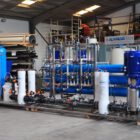Wet oxidation
Wet oxidation is an effective method for treating heavily contaminated wastewater that is not accessible to conventional processes. In addition to classic wet oxidation, there are further developments such as chemical oxidation and UV-assisted wet oxidation, which are tailored to specific requirements and pollutant profiles. These technologies extend the range of applicable








